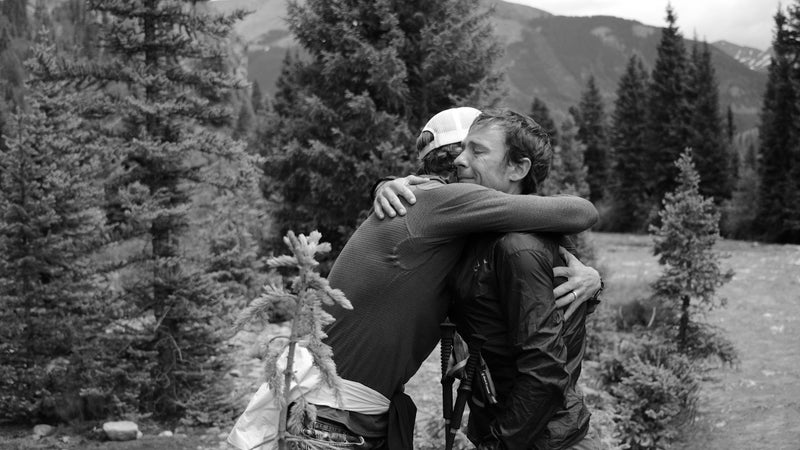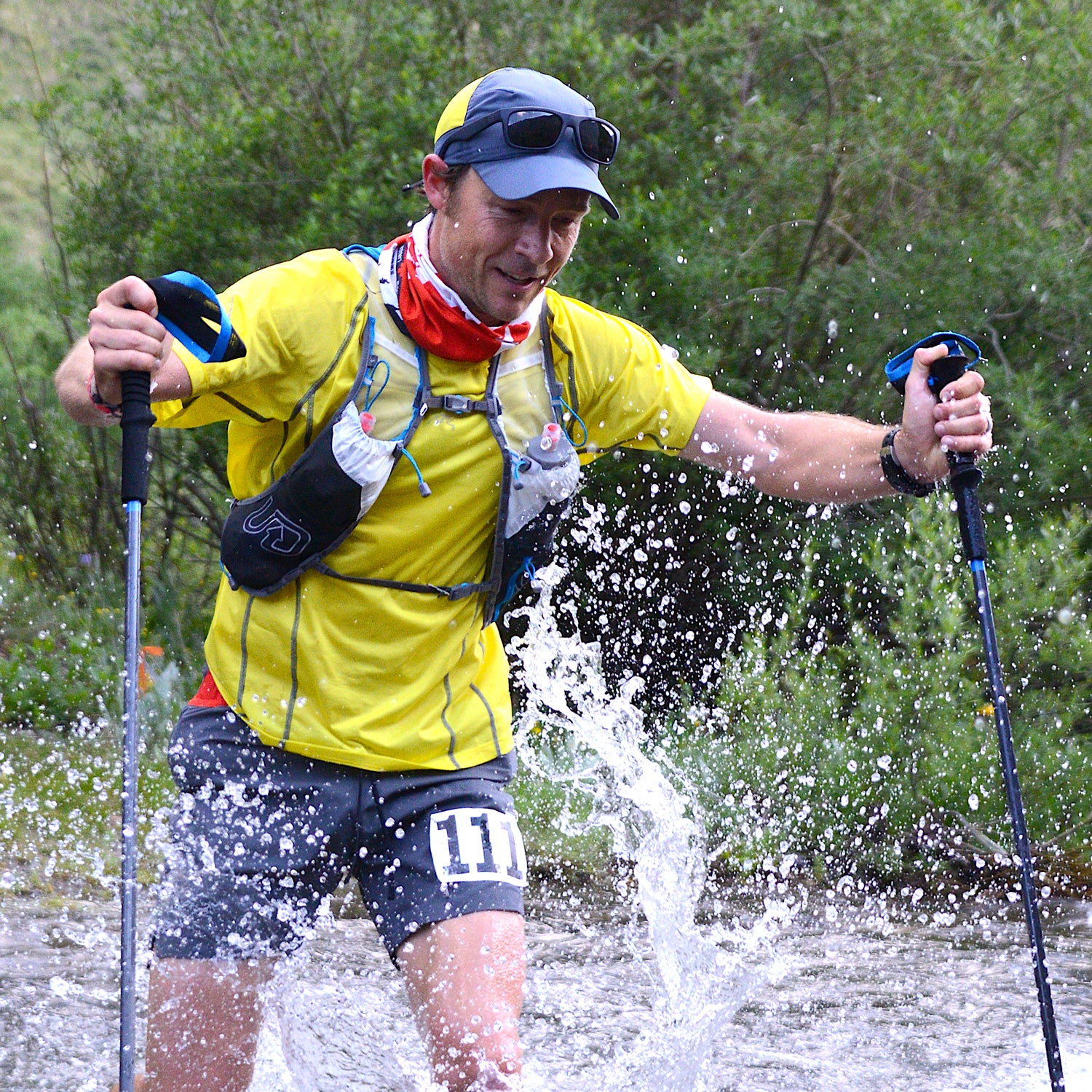“I remember seeing the mountains flipped upside-down and thinking, ‘This is the last thing I’ll ever see,’” said Adam Campbell, right before finishing the on July 15. I was walking into the finish with him and Nick Elson, a 33-year-old from Squamish, British Columbia
The three of us had been together in August 2016 when Adam took a 100-foot fall off a jagged Canadian ridgeline that nearly ended his life, let alone his running career. Nearly a year later, Nick and I had joined Adam for the final two miles of the 2017 Hardrock, one of the hardest ultramarathons in the world, in southwest Colorado. Though all three of us are professional runners and are known for being competitive, the pace was slow, even casual. Adam had developed a limp over the last 99 miles and was making liberal use of his hiking poles. His legs were filthy, his face ashen, but for the most part he was collected and seemed relaxed. Despite everything, Adam seemed most excited, after 33 brutal hours in the San Juan Mountains, simply to be able to sit down soon.

Adam, a 38-year-old lawyer who lives in Canmore, Alberta, has long been an all-around mountain athlete, excelling at ski-mountaineering, climbing, and skiing. But he gained a different kind of notoriety in 2014 when he and his pacer were nearly struck by lightning on top of 14,058-foot Handies Peak in the middle of his first run at Hardrock. They were close enough to the strike that it knocked both of them down and destroyed the batteries in their headlamps, but they escaped unscathed, and Adam went on to finish in third place. I have raced against him for years, and we’ve come to be good friends. Last summer, Adam introduced me to Nick, who instantly blew me away on several runs above Squamish with his poise and skill in technical terrain. Deciding that we formed the perfect mountain-running triumvirate, the three of us met at , in eastern British Columbia, late last August to attempt a single-push “run” of the Horseshoe Traverse, a 13-peak linkup that is not normally measured in miles so much as days. It was an ambitious goal that involved climbing up to 5.7 and significant glacier travel, but we hadn’t gotten to any of the fun stuff yet when it all went wrong.
Adam pulled on the wrong rock at the wrong time, and it came loose. He was caught off balance, and the rock took him cartwheeling backward over ledges among a chaotic avalanche of dirt and rock. Nick and I watched this take place over a span of time that lasted longer than I would have thought possible. It looked like he was going to stop on each ledge, but he kept tumbling. I actually looked away for part of it, not wanting to see my friend die, but then I decided that I needed to see what happened and where (or if) he came to a stop. So I looked back. He ended up facedown on a lower-angle scree slope. A cascade of rocks tumbled past him and off the next cliff, disappearing into the chasm below. Then, suddenly, the mountains were silent. A thin film of dust settled on everything.
, but alive and even conscious. His helmet was bloody and nearly broken in half. We learned later that he had broken three vertebrae, his pelvis, a foot, and an ankle, in addition to sustaining a concussion and major lacerations across his body (including one on his hip big enough that the doctors did surgery on his pelvis through it). After Adam came to a stop, Nick and I jumped into the only real action available to us: We climbed down to him and called search and rescue. Adam called out as we descended; hearing his pitiful voice was a relief. Even more of a relief was seeing his feet moving as we picked our way down the ledges, wary of causing more rockfall. We reached Adam within minutes, covered him with a space blanket, and kept him company until the professionals showed up.
We saw him in the hospital that night and the next day, but by that point, Adam was in the care of his family and the doctors, and there wasn’t anything left for us to do, so Nick and I left. Nick drove back to Squamish, and I started the long drive to Colorado. I didn’t see either man again until the day before Hardrock 2017.
We had a lot to catch up on. Relaxing in the afternoon sun on the day before the race, Adam told me stories about . About his injuries being so severe that doctors weren’t sure he’d ever run again. About his digestive system shutting down for a week after surgery. About getting stuck in shallow mud while fishing and needing his girlfriend to pull him out. About being in pain while doing Shavasana pose on a hardwood floor because his injured vertebrae now bulge outward. About pool running for hours. Skiing with a back brace. Becoming friends with the Canmore elderly community, with whom he suddenly had a lot in common.
By November, Adam was thinking about running again, and in December, he learned he had received a spot in Hardrock via the race’s lottery system. Suddenly he had to expand his focus from simply moving unassisted to finishing one of the hardest races in the world. The truth is that I think Adam would struggle more with not running Hardrock. Competing in mountain races and being part of that community is what gives him a sense of identity. It’s the paradox of the mountain athlete: You’re often healthiest mentally when you’re hurting physically.
So, at 6 a.m. on Friday, July 14, Adam put his hand on the rock painted with the race’s logo of a bighorn sheep, and then, when race director shouted “Go!,” Adam ran. The course is a loop, and he hoped to kiss that rock 100 miles later after one of ultrarunning’s greatest mountain tours. The effort nearly broke him, and he was nowhere near the podium this time, but Adam was consistent and seemed to take energy from the event. Nick and I joined him for the end as a sort of full-circle culmination of the experience, and I think we all expected to sob our way to Adam’s incredible success. But being emotional felt somehow scripted. So Nick and Adam talked about law stuff, and I chimed in with interesting observations like, “Check out those sweet clouds!” Adam was too shattered to run anyway, so we just walked into town.
Then, half a block from the finish, the crowd began cheering, and our lightheartedness evaporated. Everyone burst into tears like fire hydrants come unscrewed. His face streaming with tears, Adam gave his pacers and crew long hugs, and then walked slowly down the finishing chute, grasping hands and saying kind words to friends. The crowd cheered nonstop, everyone shocked as much by the power of community as with Adam’s accomplishment. When he finally reached the infamous rock he had left 33 hours before, Adam embraced Dale for a long time before finally kneeling down, grasping the rock with complete trust, and kissing the painted sheep right on the lips.


